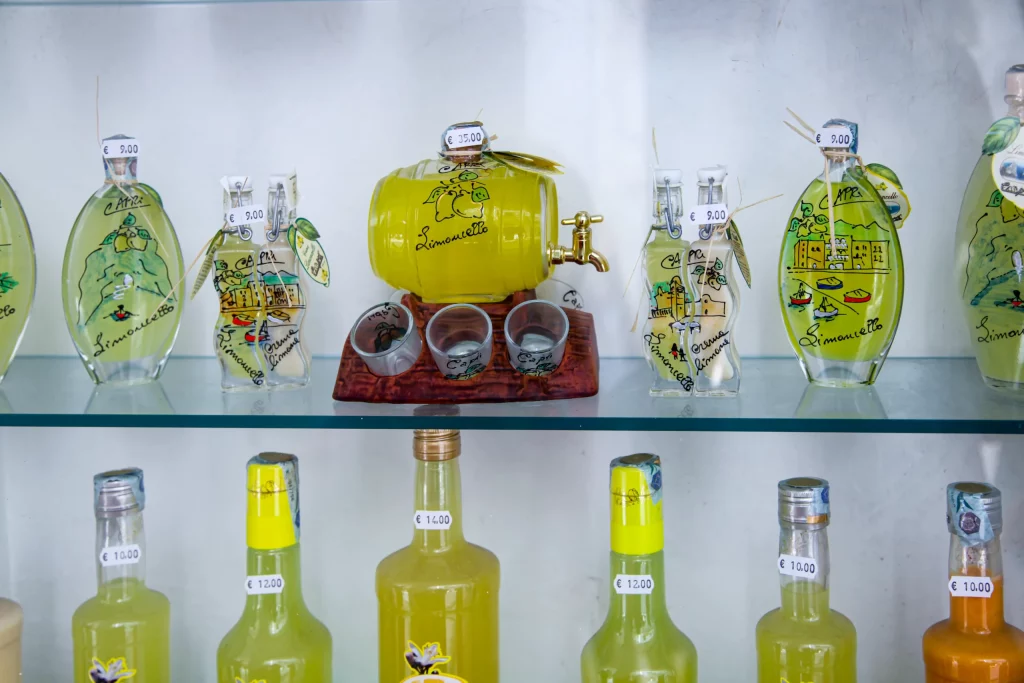I’ve found myself on a few occasions ordering a wrong digestive, thinking it is something else. Italian Digestives vary and it can become quite confusing to choose when you are asked “Che digestivo vorresti prendere?” What digestive do you want? If you have a sweet tooth or love it strong and bitter, I hope this blog post will help you understand better what to opt for after dining.
What's inside?
What is an Italian Digestive Drink?
In Italy, a meal is not just about savoring delicious food; it’s an experience that involves a journey through flavours and traditions. One essential aspect of this culinary journey is the “digestivo,” which is more than just a drink; it’s a cultural ritual deeply ingrained in Italian dining. The term “digestivo” comes from the Latin word “digestivus,” meaning “aiding digestion.” It refers to the post-meal drinks Italians enjoy to help ease the digestive process and round off a satisfying dining experience.
Types of Italian Digestives
These Italian digestives offer a diverse range of flavors and styles, allowing you to choose the one that best suits your palate and complements your dining experience:
- Amaro: Amaro is a bitter herbal liqueur that aids digestion. It comes in various regional variations, with ingredients like herbs, roots, and citrus peels, and is often enjoyed as a post-meal drink.
- Grappa: Grappa is a strong grape-based brandy, typically made from the leftover grape pomace after winemaking. It has a potent flavor and is known for its warming and digestive properties.
- Sambuca: Sambuca is an anise-flavored liqueur that is clear and often enjoyed with three coffee beans (known as “con la mosca”). It has a sweet and licorice-like taste.
- Limoncello: Limoncello is a lemon-flavored liqueur, originating from the Amalfi Coast. It is sweet, vibrant, and citrusy, making it a refreshing choice for a digestive.
- Fernet-Branca: Fernet-Branca is a complex and bitter amaro known for its intense flavor. It’s often consumed as a shot or mixed into cocktails.
- Aperol: Aperol is a lighter and less bitter orange-flavored liqueur. It’s commonly used to make the Aperol Spritz cocktail and is considered a milder digestive.
- Vecchia Romagna: Vecchia Romagna is a brand of Italian grape-based brandy known as Brandy di Vitigno. It’s aged in oak barrels, offering a smooth and rich post-meal option.
- Montenegro: Amaro Montenegro is a well-balanced and aromatic liqueur with a blend of over 40 botanicals. It has a sweet and herbal profile, making it a popular choice.
- Cynar: Cynar is an artichoke-based bitter liqueur with herbal notes. It’s known for its unique flavor and is often enjoyed on the rocks or as a cocktail ingredient.
- Liquore Strega: Strega is an herbal liqueur known for its yellow color and distinctive taste. It includes a secret blend of over 70 herbs, spices, and botanicals.
- Liquore Galliano: Galliano is a bright yellow herbal liqueur with a vanilla and herbal flavor profile. It’s used in cocktails like the Harvey Wallbanger.
- Liquore Tassoni: Tassoni is an Italian bittersweet and citrusy liqueur made from chinotto oranges. It has a unique flavor profile and is often enjoyed as a digestive.
What is a Digestive Limoncello?
Among the diverse array of digestives, one that stands out is Limoncello. This vibrant, lemon-flavored liqueur is a specialty of the Amalfi Coast and Southern Italy. Limoncello is made from the zest of ripe Sorrento or Amalfi lemons, pure alcohol, water, and sugar. The result is a bright yellow liqueur with a sweet and zesty flavor that offers a burst of sunshine in every sip.
What is a Digestive Liquor in Italian?
The term for a digestive liquor in Italian is “liquore digestivo”. It encompasses a wide range of alcoholic beverages enjoyed post-meal. These liquors are crafted to aid digestion and cleanse the palate, leaving diners feeling refreshed and satisfied. Apart from Limoncello, Italian digestivo liquors include Amaro, Grappa, Sambuca, and many more, each with its unique flavour profile and regional significance.
How Do You Drink Digestivo?
The art of consuming digestivo is not merely about the drink itself; it’s also about the ritual and the company you share it with. Here’s a typical way to enjoy a digestivo:
- Chilled and Straight: Most digestives are served chilled, straight from the freezer. The cold temperature enhances the flavors and provides a refreshing contrast to the warmth of a meal.
- Small Sips: It’s not about downing a shot; instead, take small sips to savor the complex flavors. Enjoy the aroma and let it linger on your palate.
- Conversation: Digestivo is best enjoyed in the company of friends or family. It’s a moment to relax, chat, and digest both food and experiences.
- No Rush: There’s no hurry to finish a digestivo. It’s about savoring the moment and allowing the drink to work its magic on your senses.
Why Do Italians Drink Limoncello After a Meal?
Limoncello, with its refreshing lemony flavor, is a popular choice for a post-meal digestive, and it’s not just because it tastes delightful. Here are some reasons why Italians choose Limoncello after a meal:
- Digestive Properties: Lemon is known for its digestive properties, aiding in the breakdown of food and reducing discomfort after a rich meal.
- Cleansing the Palate: The citrusy brightness of Limoncello cleanses the palate, leaving a feeling of freshness and satisfaction.
- Tradition and Culture: Limoncello is deeply rooted in Italian culture, especially in the southern regions. It represents the warmth and hospitality of the locals.
- A Symbol of Sunshine: Lemons, the primary ingredient in Limoncello, are a symbol of the Mediterranean sun. The liqueur embodies the essence of the Italian coastline, making it a perfect conclusion to a meal.
In conclusion, the world of Italian digestives is a rich tapestry of flavors, history, and culture. Whether you choose Limoncello for its zesty charm or opt for another digestivo to suit your palate, the ritual of savoring these after-dinner delights is a beautiful way to conclude an Italian meal. It’s a reminder that dining is not just about sustenance; it’s a sensory journey that nourishes both body and soul. So, next time you find yourself in Italy or at an Italian restaurant, don’t forget to indulge in the tradition of the digestivo — it’s a taste of la dolce vita, the sweet life.






